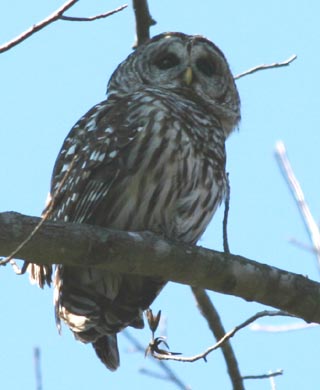Bird in Focus- Barred Owl
by Chris Showalter

f

Barred Owl
The Barred Owl (Strix varia) is a large, fairly common owl in the forests of the Eastern United States. It goes by many other names, but is probably known best as the “hoot” owl. Since the 1960s, Barred Owls have been expanding their range westward, taking advantage of new habitats. Scientists have found that populations increase faster in suburban settings than in old growth forests.
One common misconception is that Barred Owls are strictly nocturnal animals (animals that are active at night and inactive during the day). They are most often heard after dark, but Barred Owls would actually be better described as crepuscular. Crepuscular is a term used to describe animals that are primarily active during the twilight -- at dawn and at dusk. In fact, these birds are known to do the majority of their hunting at dawn and dusk. In addition, they can be quite active during the day (diurnal) when raising owlets (baby owls) or on overcast days.
The Barred Owl is an amazingly efficient predator. Their primary food is mice and other small rodents, but they have also been noted for preying on rabbits, foxes, Opossums, feral cats, and birds such as grouse and doves. There are even reports of them wading into water to capture fish!
Barred Owls have a very distinctive call. Many bird watchers think it sounds like the owl is saying “Who cooks for you?” while calling (click here to listen). It is a lot of fun to hear or see an owl…so be on the look out in your neighborhood or local woodlot during the late evening and early morning hours!
Images by Dr. Larry Wilson. Pictures property of Fernbank Science Center Conditions of Use
Click here for the "Birds in Focus" archive
